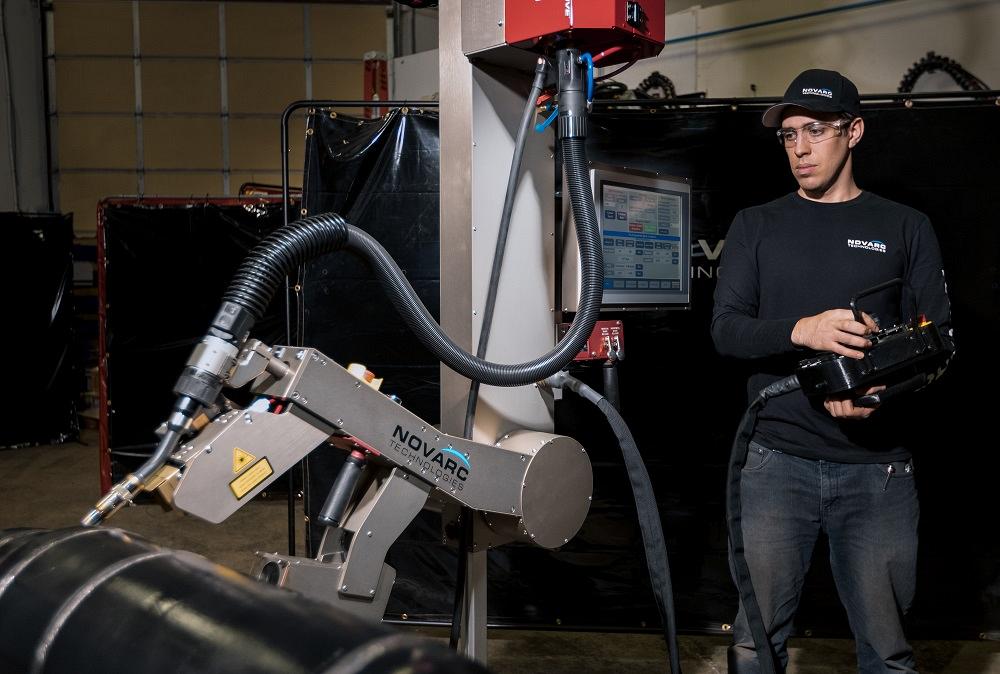Chief Revenue Officer
- FMA
- The Fabricator
- FABTECH
- Canadian Metalworking
Categories
- Additive Manufacturing
- Aluminum Welding
- Arc Welding
- Assembly and Joining
- Automation and Robotics
- Bending and Forming
- Consumables
- Cutting and Weld Prep
- Electric Vehicles
- En Español
- Finishing
- Hydroforming
- Laser Cutting
- Laser Welding
- Machining
- Manufacturing Software
- Materials Handling
- Metals/Materials
- Oxyfuel Cutting
- Plasma Cutting
- Power Tools
- Punching and Other Holemaking
- Roll Forming
- Safety
- Sawing
- Shearing
- Shop Management
- Testing and Measuring
- Tube and Pipe Fabrication
- Tube and Pipe Production
- Waterjet Cutting
Industry Directory
Webcasts
Podcasts
FAB 40
Advertise
Subscribe
Account Login
Search
Keys to adopting welding automation successfully
How leadership and workplace culture influence welding automation acceptance
- By Arash Nejad
- Updated March 15, 2024
- March 14, 2024
- Article
- Automation and Robotics

Implementing robotics and automation in welding isn't just about the technology—it's about the people.
The world of welding and fabrication is on the brink of a renaissance. Present-day automation and robotics draw inspiration from Leonardo da Vinci’s “robotic knight,” a 15th century technological innovation that could be programmed, in an analog sense, to mechanically replicate a number of human actions. Five hundred years later, Leonardo’s creativity served as a source of inspiration for NASA robots. Ingenuity in human history draws a straight line from 200 B.C. to the CNC machines of the 1950s and to the state of welding automation today.
Metal fabrication’s pursuit of increased productivity, cost-effectiveness, enhanced quality, and insightful analytics has drawn it inexorably toward these marvels of technology. Yet, in this race for progress, many robotic and automation systems fail to deliver.
The question is why?
A recent report by the Centre for Economics and Business Research identified that companies allocate nearly 15% of their annual revenues to automation, amounting to an incredible $4.5 trillion in the U.S. alone—a stunning corporate investment. With that much at stake, it is critical to address an often overlooked and uniquely human element: resistance to change.
Helping Employees Manage Change
We are, by nature, suspicious of change. The human reflex to change can influence psychological, social, and economic issues. This resistance to change can result from uncertainty, fear of losing control, the scars of past experiences, or a deficit of confidence and trust in leadership. Any one of these reactions can be expected to cause issues for the introduction of new directions, new influences, and new technology, especially in a traditional work environment where the ability to question or even caution could be interpreted as counterproductive. When change initially threatens a worker’s self-worth, or possibly their job, suspicion can easily turn into rejection.
Given technology’s role in today’s world, the introduction of automation and robotics, which can be considered as a renaissance, can turn into an HR minefield.
Two quotes from influential visionaries are relevant to this discussion:
“A vision without execution is hallucination.” –Thomas Edison, cofounder of General Electric (GE)
“Culture eats strategy for breakfast.” –Peter Drucker, Austrian-American scholar and founder of modern management techniques
Edison’s hyperdisciplined words emphasize the need for a well-defined strategy, whether a company is implementing a state-of-the-art automation system or introducing robotics to its production line. The more interpretive Drucker points out that a strategy can look good on paper, and may even be the correct strategy, but everything can still go sideways without a supportive, empowering culture.

Successful change-management depends on leadership engagement, comprehensive training, unwavering support, continual assessment, feedback, and celebration of triumphs big and small.
Drucker and Edison are both right because implementing a state-of-the-art automation solution or cobot into a production line is just one piece of the puzzle. Equally crucial is the cultural shift and effective change-management in an organization required to guarantee success. But change-management isn’t just a checklist; it’s a sophisticated domain, often necessitating the expertise of external consultants in organization psychology and seasoned change-management professionals.
Successful change-management hinges on six key pillars:
- Leadership engagement
- Comprehensive training
- Unwavering support
- Continual assessment
- Feedback
- Celebration of each triumph, no matter the size
Trust is the cornerstone of these pillars. How can a team embrace a robotic counterpart if there's an apparent deficit of trust within the ranks?
Company leaders should think long and hard about how much trust their teams are willing to place in them. Is leadership upholding the pillars of trust—equity, warmth, and rapport? By consistently evaluating and intentionally building that trust, leaders can introduce change with much more confidence in achieving a successful outcome. Remember that growth and comfort are mutually exclusive in a corporate environment. They repel each other with a visceral force.
Communication, in both directions, is a critical element in change- management. Leadership must be acutely aware of any resistance within the team and the reasons behind their reluctance, and then tailor an approach designed to address the well-being and individual needs of each member.
Often, employees who have to learn new skills or perform different tasks and procedures may feel that the onus is on them. But if they see senior executives adapting and changing as well, they’re more likely to buy into the team approach and its goals.
It is also important and essential to identify, enlist, and inform influential and veteran employees about the change and its subsequent benefits to inspire those who may feel too far removed from the top-down decision-making process. Peer-to-peer communication is more motivating and often goes a lot farther in gaining broad acceptance than a memo from the CEO. With that broad support, companies can navigate team dynamics effectively, fostering a culture ripe for growth and reaching its measurable goals.
When leading through change, companies should choose empathy over sympathy. Empathy demonstrates an awareness and understanding of individuals' concerns and genuine support for the team’s efforts in navigating through change. On the other hand, sympathy is a reaction to a negative outcome. It will reflect negatively on how the leader views the effect of change on others.
How Can Companies Succeed?
In conclusion, the implementation of robotics and automation in metal fabricating companies isn't just about the technology; it is also about the people. A solid corporate culture is built by people, for people. It personifies the company, giving employees, customers, and suppliers credible reasons to assess and hopefully accept the values of that company. By cultivating a supportive culture, managing change adeptly, and fostering trust at every level, companies can not only adapt to the future; they can weld it onto their vision.
About the Author

Arash Nejad
206-267 W. Esplanade
North Vancouver, V7M 1A5 Canada
(236)-477-5347
About the Publication
Related Companies
subscribe now

The Welder, formerly known as Practical Welding Today, is a showcase of the real people who make the products we use and work with every day. This magazine has served the welding community in North America well for more than 20 years.
start your free subscription- Stay connected from anywhere

Easily access valuable industry resources now with full access to the digital edition of The Fabricator.

Easily access valuable industry resources now with full access to the digital edition of The Welder.

Easily access valuable industry resources now with full access to the digital edition of The Tube and Pipe Journal.
- Podcasting
- Podcast:
- The Fabricator Podcast
- Published:
- 04/16/2024
- Running Time:
- 63:29
In this episode of The Fabricator Podcast, Caleb Chamberlain, co-founder and CEO of OSH Cut, discusses his company’s...
- Trending Articles
Sheffield Forgemasters makes global leap in welding technology

ESAB unveils Texas facility renovation

Engine-driven welding machines include integrated air compressors

How welders can stay safe during grinding

The impact of sine and square waves in aluminum AC welding, Part I

- Industry Events
16th Annual Safety Conference
- April 30 - May 1, 2024
- Elgin,
Pipe and Tube Conference
- May 21 - 22, 2024
- Omaha, NE
World-Class Roll Forming Workshop
- June 5 - 6, 2024
- Louisville, KY
Advanced Laser Application Workshop
- June 25 - 27, 2024
- Novi, MI



























